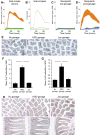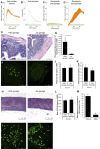Exoelectrogenic capacity of host microbiota predicts lymphocyte recruitment to the gut
- PMID: 25852170
- PMCID: PMC4491528
- DOI: 10.1152/physiolgenomics.00010.2015
Exoelectrogenic capacity of host microbiota predicts lymphocyte recruitment to the gut
Abstract
Electrotaxis, directional cell movement in response to an electric potential, has been demonstrated in a wide range of cell types including lymphocytes. Exoelectrogens, microorganisms capable of generating electrical currents, have been identified in microbial fuel cells. However, no studies have investigated exoelectrogenic microbes in fresh feces or the effects of an exoelectrogenic microbiota on the host organism. Here we show that commensal gut microbial populations differ in their capacity for electrical current production by exoelectrogens and that those differences are predictive of increased lymphocyte trafficking to the gut in vivo, despite the lack of increased production of canonical lymphocyte-specific chemokines. Additionally, we demonstrate that the difference in current production between mice purchased from different commercial sources correlates reproducibly with the presence or absence of segmented filamentous bacteria, and while our data do not support a direct role for segmented filamentous bacteria in ex vivo current production, an exoelectrogenic microbiota can be transferred in vivo via mucosa-associated bacteria present in the ileum. Moreover, we detect upregulation of microbial genes associated with extracellular electron transfer in feces of mice colonized with exoelectrogenic microbiota containing segmented filamentous bacteria. While still correlative, these results suggest a novel means by which the gut microbiota modulates the recruitment of cells of the immune system to the gut.
Keywords: electrotaxis; exoelectrogen; microbiota; segmented filamentous bacteria.
Copyright © 2015 the American Physiological Society.
Figures




Similar articles
-
The influence of rosuvastatin on the gastrointestinal microbiota and host gene expression profiles.Am J Physiol Gastrointest Liver Physiol. 2017 May 1;312(5):G488-G497. doi: 10.1152/ajpgi.00149.2016. Epub 2017 Feb 16. Am J Physiol Gastrointest Liver Physiol. 2017. PMID: 28209601
-
[Gut microbiota and development of the immune system].Med Sci (Paris). 2016 Nov;32(11):961-967. doi: 10.1051/medsci/20163211011. Epub 2016 Dec 23. Med Sci (Paris). 2016. PMID: 28008836 Review. French.
-
Role of Microbiota in Strengthening Ocular Mucosal Barrier Function Through Secretory IgA.Invest Ophthalmol Vis Sci. 2017 Sep 1;58(11):4593-4600. doi: 10.1167/iovs.17-22119. Invest Ophthalmol Vis Sci. 2017. PMID: 28892827 Free PMC article.
-
Lactobacillus gasseri KS-13, Bifidobacterium bifidum G9-1, and Bifidobacterium longum MM-2 Ingestion Induces a Less Inflammatory Cytokine Profile and a Potentially Beneficial Shift in Gut Microbiota in Older Adults: A Randomized, Double-Blind, Placebo-Controlled, Crossover Study.J Am Coll Nutr. 2015;34(6):459-69. doi: 10.1080/07315724.2014.983249. Epub 2015 Apr 24. J Am Coll Nutr. 2015. PMID: 25909149 Clinical Trial.
-
Regulation of virulence: the rise and fall of gastrointestinal pathogens.J Gastroenterol. 2016 Mar;51(3):195-205. doi: 10.1007/s00535-015-1141-5. Epub 2015 Nov 10. J Gastroenterol. 2016. PMID: 26553054 Free PMC article. Review.
Cited by
-
Long-Term Mesophilic Anaerobic Co-Digestion of Swine Manure with Corn Stover and Microbial Community Analysis.Microorganisms. 2020 Jan 29;8(2):188. doi: 10.3390/microorganisms8020188. Microorganisms. 2020. PMID: 32013160 Free PMC article.
-
Healthy gut microbiomes are host-controllable microbiomes.Front Microbiol. 2025 Jan 8;15:1497083. doi: 10.3389/fmicb.2024.1497083. eCollection 2024. Front Microbiol. 2025. PMID: 39845029 Free PMC article. No abstract available.
-
Leuconostoc mesenteroides mediates an electrogenic pathway to attenuate the accumulation of abdominal fat mass induced by high fat diet.Sci Rep. 2020 Dec 14;10(1):21916. doi: 10.1038/s41598-020-78835-9. Sci Rep. 2020. PMID: 33318546 Free PMC article.
-
Leuconostoc mesenteroides utilizes glucose fermentation to produce electricity and ameliorates high-fat diet-induced abdominal fat mass.Arch Microbiol. 2022 Oct 14;204(11):670. doi: 10.1007/s00203-022-03281-2. Arch Microbiol. 2022. PMID: 36241916
-
Degradation of Veterinary Antibiotics in Swine Manure via Anaerobic Digestion.Bioengineering (Basel). 2020 Oct 9;7(4):123. doi: 10.3390/bioengineering7040123. Bioengineering (Basel). 2020. PMID: 33050352 Free PMC article.
References
-
- Call DF, Logan BE. A method for high throughput bioelectrochemical research based on small scale microbial electrolysis cells. Biosens Bioelectron 26: 4526–4531, 2011. - PubMed
-
- Campbell JM, Fahey GC Jr, Wolf BW. Selected indigestible oligosaccharides affect large bowel mass, cecal and fecal short-chain fatty acids, pH and microflora in rats. J Nutr 127: 130–136, 1997. - PubMed
Publication types
MeSH terms
Grants and funding
LinkOut - more resources
Full Text Sources
Other Literature Sources
Molecular Biology Databases

